A13 Mk.III Cruiser Mark IV tank
This British A13 Cruiser MkIII tank with Mark IV turret can be seen at the Tank Museum, Bovington, Dorset England. It is one of the few examples to survive. Many were left in France and destroyed in 1940. Those that went to North Africa in 1941 broke down and left where they stood or were knocked out by the Germans.
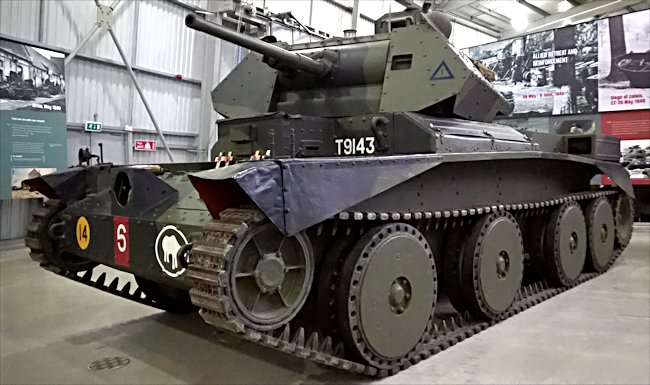
A13 Mk.III British Cruiser MkIV tank at Bovington Tank Museum
10th Hussars
Ron Huggins volunteered at the Tank Museum around 1985 he was writing a history of the 10 Hussars, he joined the regiment as a boy soldier when they were still a cavalry regiment. Ron served in France and in North Africa, David Fletcher's book on the Crusader has the art work of Ron's A13 Tank the Saint. The Tank Museum's A13 was given the same livery as Ron's Tank in France Sept 1939-May 1940. Ron was a wonderful old chap sadly he passed a couple of years ago.
A13 Mk.III Cruiser Mk IV tanks sail to Egypt October 1940
Tank Commander Sergeant Gerry Solomon was given orders with his tank crew to sail Egypt to help reinforce the British contingent that was trying to repel the invading Italian army. He recalls, "I was excited about going abroad. It was like an adventure. We were regarding it as a source of sightseeing tour."
On the morning of Christmas Eve 1940, after two months at sea, the 5th Royal Tank Regiment gathered on the dockside of the port of Alexandria. At the front a small force of British troops had managed to stop the Italian advance and had counter-attacked. Many Italian prisoners had been taken. The Italians started to retreat back into Libya. The British army followed them. The newly arrived tank crews started to believe they would not be needed. They were very, very wrong.
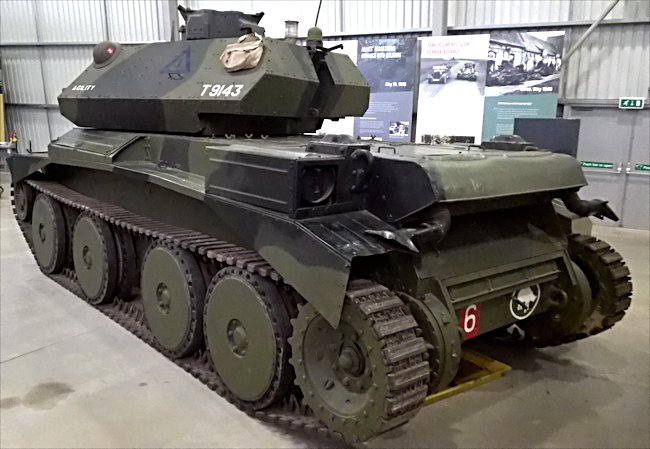
The British did have sloping spaced armour on their A13 Mk.III Cruiser MkIV tank turret but it was a shame that it was so thin.
In February 1941 battled hardened German army arrived in North Africa, led by Rommel. The Afrika Korps had been equipped with upgraded Panzer III and Panzer IV tanks. The Germans have learnt their lessons from the battle of France. These new tank variants had better armour and longer more powerful guns. They had come to rescue their Italian allies.
The 5th Tanks had already encountered Rommel in France and lost. It was in the desert that Rommel found his perfect arena for armoured warfare. He had plans to conquer British Egypt and drive straight through to the Arabian oilfields. Rommel launched an offensive. The British headquarters in Egypt believed that he would not be ready for the months.
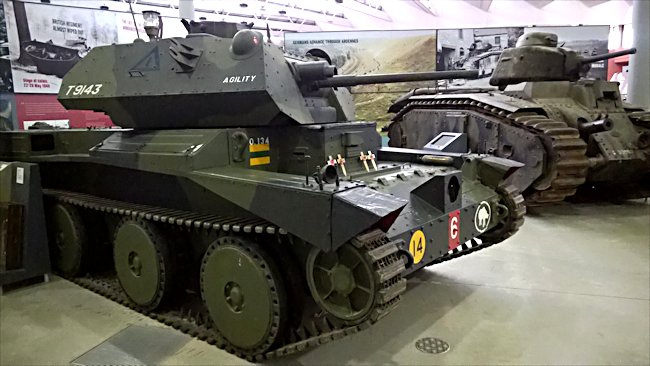
Front bolted hull on an A13 Mk.III British Cruiser MkIV tank
When the 5th Royal Tanks were attacked on 1 April 1941, April fools day, the officers informed them that it could only be the Italians. Tank Commander Corporal Harry Finlayson was 26 in 1941. He was a regular and had already seen service in India and France. He recalls, "We got into this ditch and could see tanks coming. Huge great tanks with big black crosses on them. I said, 'Bleeding Germans. We don't have Germans here'. Then we saw lorries coming with Germans in. So I went back and reported but they would not believe me. The company commander would not believe me, he said 'There are no Germans there'. I said 'Well there are'. In the morning. The tanks we had against theirs was impossible."
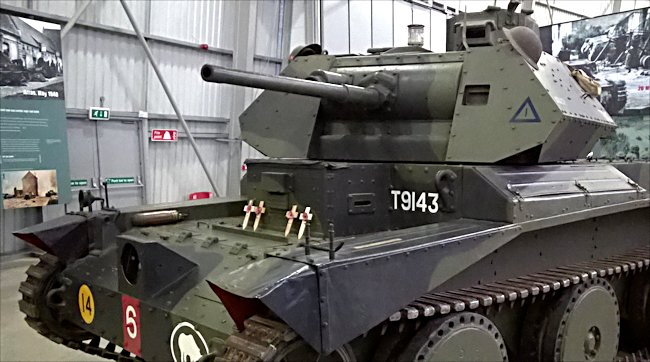
The drivers square amoured head box offered little protection on the A13 Mk.III British Cruiser MkIV tank
They knew from bitter experience that tanks like the a 13 cruiser were inferior to German panzers and anti-tank guns because they had performed so poorly in the battle of France in 1940. A13 was a death trap to the men of the 5th Royal Tanks. It was very hard to get into the tank through the very narrow armoured hatches. It was near impossible to get out of the tanks very fast when they caught on fire. This was a very poor deadly design feature. That, combined with a thin armour deprived the crew of a sense of security, which you would expect them to have inside a tank.
The 5th Tanks were facing a enemy, they were simply not prepared for. They were able to engage the Italians on an equal footing, but not these upgraded German panzers that were being unloaded in Tunisian ports. In the early part of the desert war, the German Luftwaffe had command of the skies. Its bombers and especially the Stuka dive bomber cause havoc amongst British armoured divisions. The British command structure went to pieces when Rommel attacked.
The tank crews of the weekly armed A13 cruiser tanks were up against the new and improved Panzer III, the German main battle tank of 1941. It weighed nearly twice as much as the British tanks. Most of that was protective armour. Another advantage the German tank crews had was that there panzers were more mechanically reliable.
The internal design of their tanks were much better than the British. The commander had 360° visibility in the turret so you can easily spot targets. There were large escape hatches for all crew members. They could get out of the tank much faster than the British crews. A new guns longer barrels meant that their armour piercing shells were more accurate and of higher velocity that could easily penetrate the British armour.
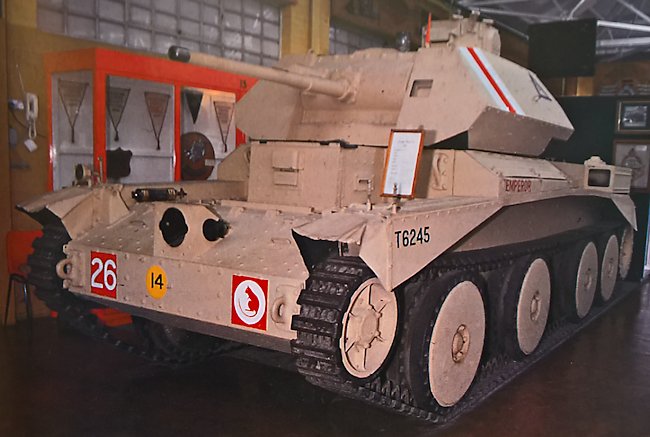
The Bovington Tank Museum A13 Mk.III British Cruiser MkIV tank was previously painted in desert livery
As the German panzers overrun the British lines, chaos and confusion occurred. Tank Commander Corporal Harry Finlayson remarked, " the funny thing was, I don't think I felt scared. I think I was more worried about my crew. I was telling the driver where to go. I felt disappointed that we did not have the power to knock Jerry's tanks out."
Lieutnant Arthur Crickmay of the 5th RTR wrote home about what he had seen, "There was confusion. Order and counter order. My most vivid memory is one of our tanks exploding. All the ammo inside must've gone up at once. I have seen many tanks on fire, but I've never seen one go up like that before. The next few days were amongst the most unpleasant. I can remember."
What Crickmay knew only too well was what happened when a shell struck a tank. The projectile penetrating through one side would lack the energy to exit through the other side. It would ricochet about inside tearing people to pieces. If it struck ammunition or fuel a fire could soon start. Smoke and flames would below from the turret. Within 30 seconds the temperature inside the tank could match that of a furnace. The crew would be incinerated.
Within a week Rommel had reversed all the good fortunes the British had experienced fighting the Italians. He had recaptured all the land the Italians had lost. Rommel's strategy was good but he did not have to be brilliant. Most historians failed to take into account the poor condition of the British eighth Army at that stage.
For example, of 5th Royal Tank Regiment 52 tanks only 9 had been destroyed by the Germans. Amazingly 41 of them had broken down in the desert. How good did the Afrika Corps have to be when the British had tanks like this. Bad British mechanical design and poor testing was winning the war for the Germans.
British Armoured Divisions in France 1940
The British 1st Armoured Division was equipped with a variety of different cruiser tanks: the Mark I A9, Mark II A10, Mark III A13 and Mark IV (A13 Mark II). They all saw service in France during 1940 when the Germans unleashed their blitzkrieg attack.
In the Kiev maneuvers of 1936, foreign military observers were shown hundreds of the new Russian BT 'fast' tanks as they rolled by a reviewing stand. They were based on an American designed tank by the Christie Corperation that the US military never used. In the audience were British Army representatives, who returned home to advocate the use of Christie suspension on British cruiser tanks. It was incorporated from the Cruiser Mk III onwards.
British tank designers had planned to arm them all with a three pounder (47mm) main gun, but they ended up with the new 2 pounder (40mm) gun. On the face of it, this seems like a poor choice. In fact it was the right choice as the two pounder had a higher muzzle velocity and better penetration qualities.
The 2nd Royal Tank Regiment was deployed to France in 1940. It was part of the British 1st Armoured Division. It was kitted out with the new A13 cruiser Mark IVA tanks. They were essentially an up armoured version of the Mark III cruiser tank.
The Mark IV version of the cruiser tank was identifiable by the sloping V shape armour plating on the side of the turret. The difference between the Mark IV and the Mark IVA was the type of machine gun mounted in the turret. One had a Vickers machine gun the other had a Besa machine gun.
Bovington's A13 Cruiser Tank
The vehicle in the photographs was probably a training tank during world war II. It has been painted to represent the tank commanded by Sergeant Ron Huggins, 10th Royal Hussars in France 1940. There is a big gap between the top of the tracks on this tank and the top mud guard. This was a feature of the Christie suspension. It allowed the track to bounce up and down to give the tank crew a more comfortable ride over rough ground.
This helped the gunners shoot on the move more accurately. On the front of the turret is a small hole to the right of the main gun. This is where the gunner took aim using a telescope. The white rhino badge on the front of the tank was the crest of the British 1st Armoured Division which fought in France in 1940.
The battle of Huppy 27th May 1940, France
There are no surviving complete British A13 Cruiser MkIV Tanks left. Only the MkIV turret on the Mk III chassis on the Bovington tank survives. This is an account of what happened when a a Squadron of these tanks attacked a German Flak Gun battery during the Battle of France 1940. The following is from an 88mm German Flak Battery Commander's account of what he saw.
Among the thin 'infantry screen' which the riflemen form, stretching out to the south, stands our flak battery. The 88mm Flak gun, 'Caesar', is positioned 300 metres (330 yards) to the east of the road that leads south to Huppy. It is there to cover against tank attacks from the south and south-east, the direction of Huchenneville. We have been lying in wait for two days when the first enemy tanks finally heave into view at the edge of the wood.
They are British Cruiser Mk IV tanks belonging to the 10th Hussars, part of the 3rd Armoured Brigade, 1st Armoured Division. It would do them too much honour to call their appearance an 'attack'. They approach hesitantly, dart to and fro like grey shadows along the edge of the wood, shudder, come to a halt, and seem not too clear about where to attack.
Quiet now! Our Caesar is going to show what he can do. Raise the sights slightly! Then fire! Completely calm, the Number 2 on the gun takes aim. 'Got the range!' — 'Fire!' After 10 shots, two tanks are in flames, burning fiercely. So much for that! Badly damaged, the third tank withdraws into the safety of the woods. We were firing as though on the range.
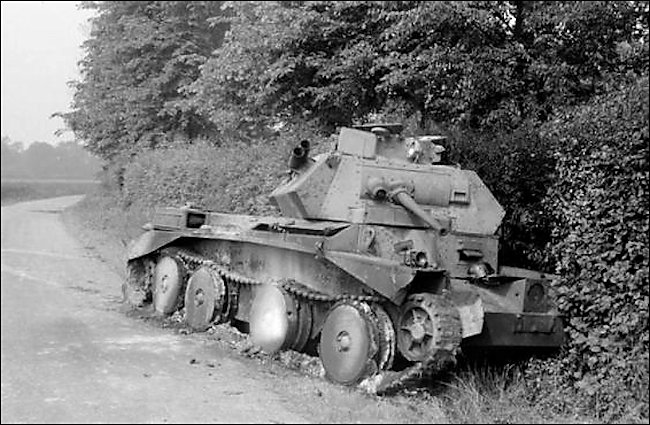
Knocked out A13 British Cruiser MkIV tank during the battle of Huppy 27th May 1940, France
Not long afterwards, stronger enemy tank forces prepare for a new attack. And once again Caesar 'speaks', quickly and surely finding his range and flinging shell after shell at the enemy's armour. Don't spare the ammunition! The bright torches are burning once more out there ahead of us! Seven tanks standing at the foot of the ridge are knocked out by direct hits. A few of the attackers, some damaged, succeed in retreating to the Village of Huchenneville.
The penetrative force of our shells is colossal. If they achieve a square hit on target, they pierce the monsters' armour and send them up in flames. Often, when the impact is too flat, they bounce off — like pebbles skimming a pond — over the tank turrets, followed by a shower of sparks. For the moment, though, we've done it! They are all in chaos over there, and the sight of the burning brutes will not be exactly encouraging for those coming up behind.
We do not realize until later how much we were under the spell of the lust for battle. Just one example: while the lieutenant was kneeling in the singed grass, his eye pressed to the telescopic sight, giving orders, shouting, disappearing occasionally in clouds of gun smoke, jumping into the gunner's sear and sighting the gun himself, while we ignored the enemy fire and pumped out shot after shot, kept a lookout, or hauled up ammunition, gasping and sweating — during this time, our detachment commander had arrived almost unnoticed, had quickly been briefed, and then began without a word dragging up ammunition with us. Nobody had quite taken it in, it just seemed the natural thing to do in a battle.
The next morning more enemy tanks, followed by a strong force of infantry and supported by intense artillery fire, attack in Caesar's sector again. Under fire from our trusty Caesar, standing once again exposed on all sides, the first tank daring to emerge from the wood towards the south is set alight by a direct hit. Another one is also hit and put out of action. But this is where it gets lively! Five more Cruiser tanks, break free from the wood, drive towards our free-standing gun and engage it with main and secondary armament. - Leutnant Klay.
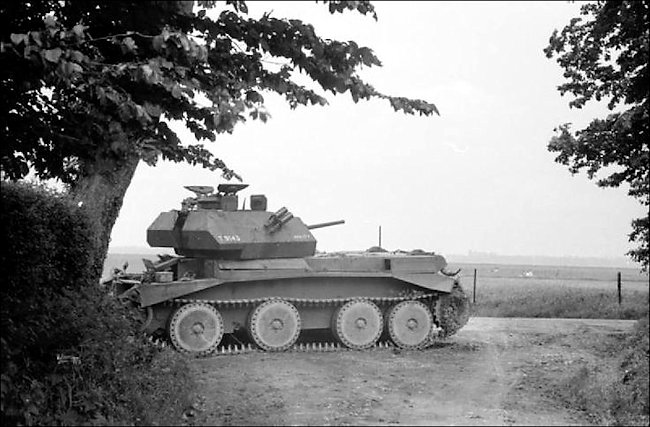
Another knocked out A13 British Cruiser MkIV tank during the battle of Huppy 27th May 1940, France
In the meantime, our own infantry has suffered losses and retreated under the impact of the enemy artillery. In Caesar's left flank the enemy has already reached the village of Villers. We have lost all protection from ahead and to the rear! But three times we throw half a dozen shells into Tommy's face. There are explosions all around us. The shrapnel clatters against the gun barrel and the gun mount. shattering the fuse setter. Explosion after explosion, near us and behind us! Three members of the gun crew are injured. The gun tractor is knocked out.
Then the gun chassis is hit. The steel monsters churn on towards us, getting closer and closer It is time to break off a contest that has become too unequal. When our gun commander is killed by a shot in the head, the last five men retreat. Caesar will never fire again. He himself has been shot to pieces. But despite everything, on this day the enemy fails to achieve his aim of getting across the bridges. A kilometer further back, still a long way from the Somme bridges, our three other heavy anti-aircraft guns put a firm stop to his advance.
Berta knocks out 21 tanks by direct hits and damages 10 others that lie immobilized. By 30 May the newly-formed Caesar crew had already taken over a new gun, with which we helped to strengthen the German defensive front, that thin line south of Abbeville. It was a line we held until our own thrust to the south.
A German account of the battle of Huppy
First light on 27 May in the Abbeville bridgehead. Wreaths of mist swirl across the road to Huppy. Staring into them are five pairs of eyes belonging to the crew serving an anti-tank gun lying in wait at an outpost by the road. Brinkforth is sitting at the telescopic sight, his hand on the firing mechanism. With a shell ready in the breech, he is waiting with icy calm for the first victim to appear.
'This damned mist!' Somewhere an early riser among the bird population is serenading the arrival of morning. The anti-tank men do not hear it, all they hear is a muffled clattering and droning. They know what that is — tanks! To the ears of a tank destroyer, it is better music than the dawn chorus.
Every nerve is stretched. They will soon be here, the enemy's steel monsters, the terror of the infantry. But we have anti-tank shells. The No 2 on the gun runs his hands lovingly over them.
The mist slowly clears. There! They are working their way along, some heavy, some light, all Tommies [British]. They look for cover behind hedges and bushes.
One, three, five, ten, twenty, thirty! 'Damn it, a bit too much for breakfast!' Their faces are deadly serious, but determination and untamed eagerness for battle shine out of the eyes of the men behind the well-camouflaged gun. Nerves are practically at breaking point. But the enemy must be allowed to get closer. 800 metres (875 yards), 600 metres (655 yards)! The muzzle of the gun follows them menacingly.
This is a battle of wills! Out here, 6 kilometres (4 miles) ahead of the main front-line running for several kilometres around Abbéville, we must emerge victorious in order to protect our infantry comrades from this surprise attack
Thirty tanks and just one German anti-tank gun: an unequal contest! We can already make out their red, white and blue pennants. But what are they doing now? They are all turning left and moving at right angles on to the road. 'Blast it! Do you think the beggars have spotted us?' But that's impossible! They're all heading straight towards us.
With teeth clenched, the crew sit hidden behind their camouflaged, solitary gun, with no protection except for a single machine gun. We can only win here by keeping stronger nerves and a cooler head. We let them come on.
Then it's time. Calmly, as though on a training exercise, Brinkforth operates his range finder. '200 metres (218 yards), fire at will!' The order to fire sounds razor-sharp, and the shell roars out of the muzzle, to bore into the armour of a tank turret.
The gun becomes a ferocious animal. Its roaring makes the earth shake. Where there was a tank before, there is now just smoke and fire. The tank battle near Abbeville is under way. Our machine gun joins in. A hellish racket! Shell after shell screams out of the barrel. But the enemy has identified our position by the gun-flashes.
Twenty tanks aim their large- and small-calibre guns. It is raining hot steel. The projectiles strike the road to the left of us, the hedge to the right of us, the trees above us, the air is filled with crackling, hissing, humming and whistling. Branches fall. The road is pitted. But we bite our lips, as shell after shell flies towards the tanks. Brinkforth fires with icy calm. 'Next one, Hubert, then another one, easy does it!' We've got to pull it off.
Only four shells are left next to the gun. Ammunition, ammunition! Number 4 on the gun and the driver are already struggling over with the heavy boxes. They risked heavy fire to get the ammunition from the tractor to the gun when it was needed. Every man here is doing his duty. Our gun barrel is hot from firing.
Number 2 is lying among a pile of hot shell cases that fall on to his helmet and face when he tears open the breech block. But who is aware of such things? There is only one thought in the men's minds:
We must win here! One or two tanks have succeeded in crossing the road. We can no longer see them. The hedge on our right blocks our view. That is worrying. The first one appears, at 70 metres (77 yards), firing wildly into our flank. Thanks to the hole we cut in the hedge yesterday on the chief's orders, we can see him. That is our salvation. The gun traverses, and the beggar is immediately burning like a torch.
We have halted the attack, but we are still being fired upon. 'Damn! Where's that coming from?' There — on the right behind the hedge! 'Fire at the hedge!' yells the leading gunner.
It is the other tanks who escaped across the road. They daren't get as close as the first one. Our shells tear towards the gun-flashes from the hedge, and rip into the tanks. Here, too, the machine guns fall silent.
We have done it. They beat a frantic retreat, pursued by our shells. Our gun was spewing out death and destruction for 20 minutes, and 10 tanks lie in front of it, knocked out, burnt, and destroyed. The crew sit exhausted for a moment, and then have to go back on to the alert, and take prisoners.
A British captain who is among them refuses to give any information. All he will say is: 'You can be proud of your anti-tank guns. We have learnt respect for them.'
Brinkforth, the hero of the hour, was mentioned in dispatches next day for his feat of knocking out 10 tanks in 20 minutes. Today he is proud to wear the Knight's Cross of the Iron Cross, and he and the whole company are proud that their young branch of the army, the tank destroyers, has won these laurels. He is the first soldier of non-commissioned rank to receive such a high honour. By Gefreiter Wilhelm Krawzek. An extract from the book 'Blitkrieg in their own words'
Where can I find other preserved A13 Mk.III Cruiser Mk IV Tanks?
- The A13 at Bovington Tank Museum is the only surviving example
- Source - Pierre-Oliver Buan - http://the.shadock.free.fr/Surviving_Panzers.html
WW2 Tank books

